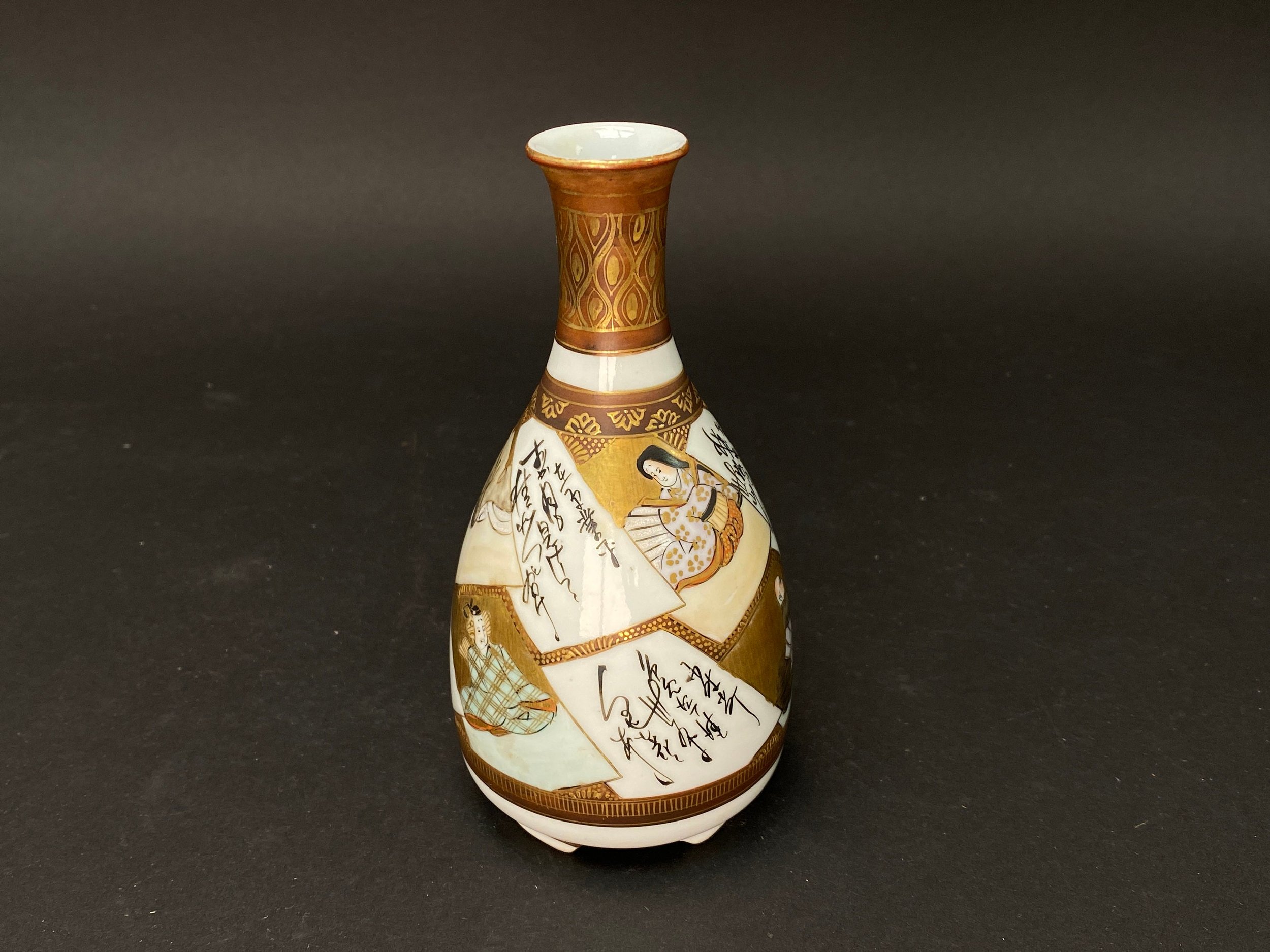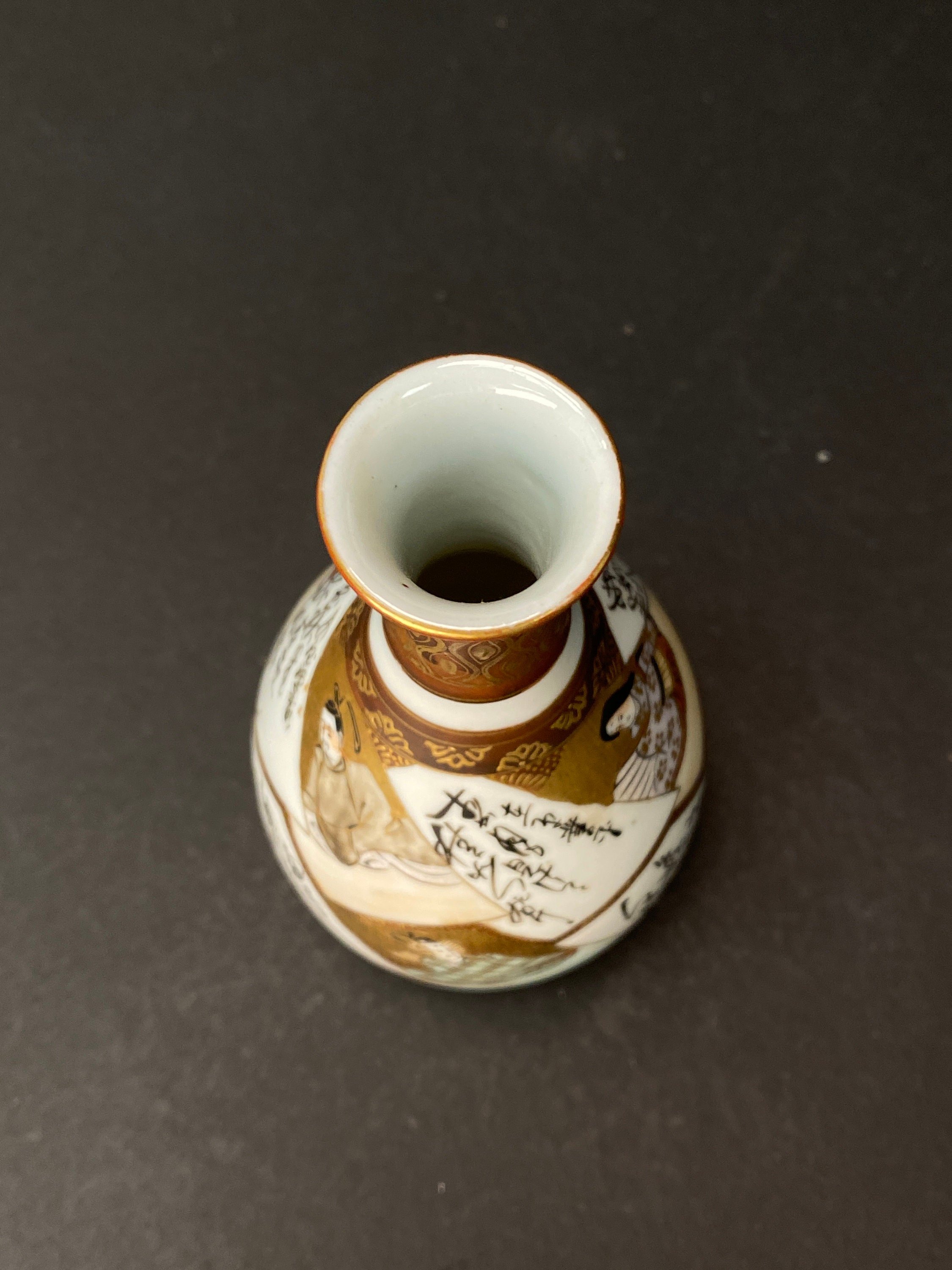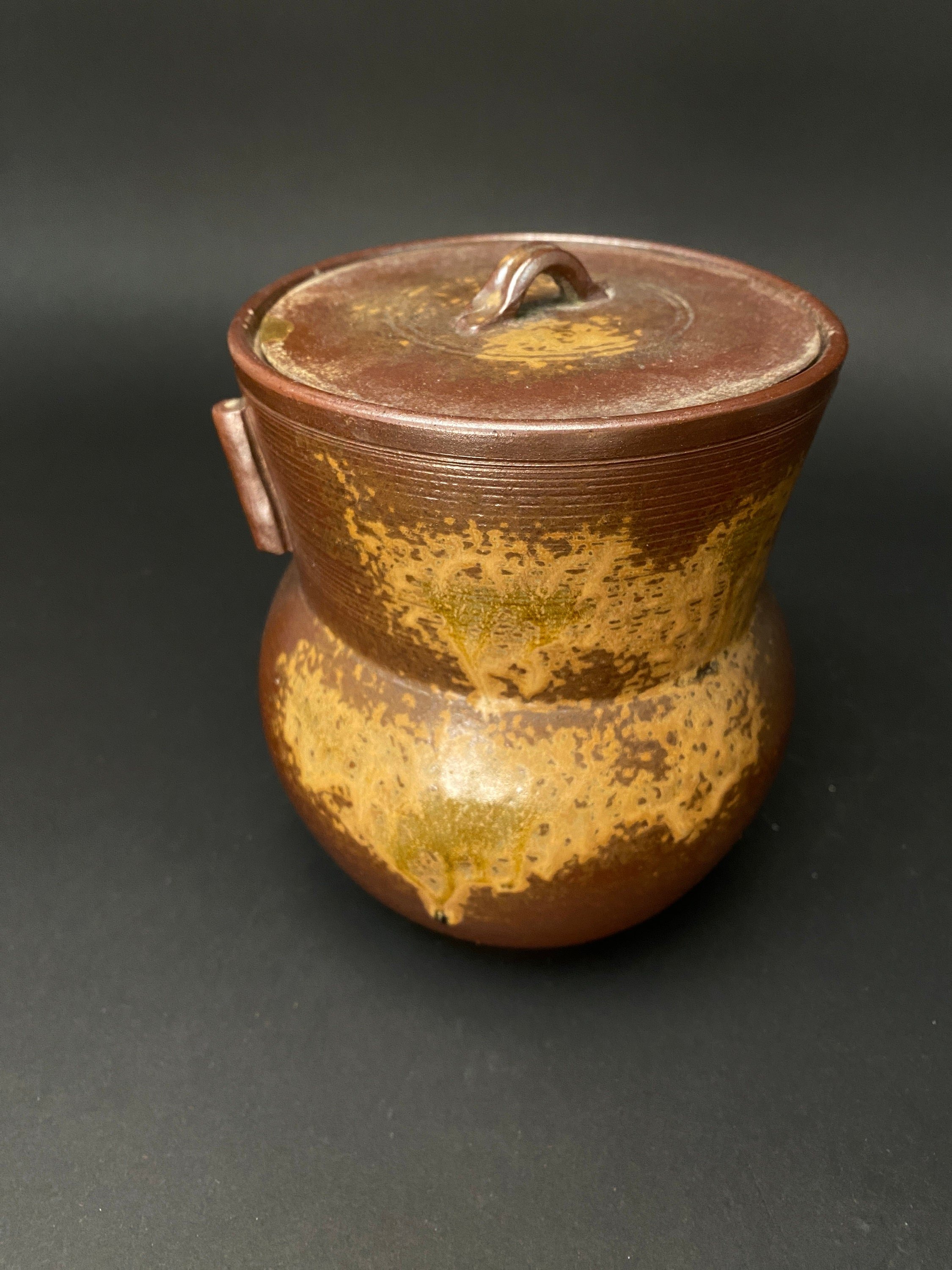 Image 1 of 10
Image 1 of 10

 Image 2 of 10
Image 2 of 10

 Image 3 of 10
Image 3 of 10

 Image 4 of 10
Image 4 of 10

 Image 5 of 10
Image 5 of 10

 Image 6 of 10
Image 6 of 10

 Image 7 of 10
Image 7 of 10

 Image 8 of 10
Image 8 of 10

 Image 9 of 10
Image 9 of 10

 Image 10 of 10
Image 10 of 10











Rare Antique Japanese Kutani Satsuma style Porcelain RARE Sake Bottle, Tokkuri, Handpainted, gold, Sake Pourer
$146.30
During the Meiji Period (1868-1912) in Japan, this Kutani Ware porcelain pot was crafted specifically for sharing sake. The design boasts large panels adorned with depictions of people in portrait, Haiku and poem, complemented by gilt flowers and Satsuma-style decorations on a warm background. The pot was skillfully made and painted at the Kutani kilns in Kaga prefecture. As an antique Japanese piece, it can also serve as a Geisha or Sake Pourer.
-It is fully handmade and hand painted Old Kutani Yaki Style Porcelain.
-Pattern: All hand painted Satsuma style.
Details
-No chips or cracks and in excellent condition.
-Colors in images between the item list and the detail page may appear differently in different devices.
-Please refer to the photos
approx. Height5 3/4"(14.5cm)
Width 2 3/4"(7cm)
Weight 5oz
About Kutani ware
Kutani ware, also known as Kutani-yaki in Japan, is a traditional type of pottery created in and around Kaga city, Ishikawa prefecture. The craft dates back to the early Edo period in the 17th century, and is known for its vibrant colors, intricate designs, and unique overglaze decoration technique. This technique involves painting a pattern on the glazed surface of the pottery with pigments and then firing the piece again. The high firing temperature of about 800℃ (about 1472℉) allows for a wide range of colors to be used. Each type of Kutani ware has its own distinct colors and style.
The history of Kutani ware began in 1655, when the Daishoji clan supported the production of the handicraft in Kutani village. A man named Saijiro GOTO was sent to Arita to learn ceramic-making techniques and brought them back to Kutani. However, the kilns producing this type of pottery were abandoned after only 50 years, with the reasons for their decline still unknown. The ceramics created during this time are referred to as "ko-Kutani" and are known for their beautiful colors and unique designs.
About a century later, Kutani ware production resumed with the support of the feudal domain. Several styles of Kutani ware were created, including Mokubei kiln in 1807, Yoshida-ya kiln in 1827, Iidaya kiln in 1831, Shozan kiln in 1841, and Eiraku kiln in 1865. Today, Kutani ware is still produced in and around Kaga city and is cherished both in Japan and internationally for its beauty and craftsmanship.
-It is fully handmade and hand painted Old Kutani Yaki Style Porcelain.
-Pattern: All hand painted Satsuma style.
Details
-No chips or cracks and in excellent condition.
-Colors in images between the item list and the detail page may appear differently in different devices.
-Please refer to the photos
approx. Height5 3/4"(14.5cm)
Width 2 3/4"(7cm)
Weight 5oz
About Kutani ware
Kutani ware, also known as Kutani-yaki in Japan, is a traditional type of pottery created in and around Kaga city, Ishikawa prefecture. The craft dates back to the early Edo period in the 17th century, and is known for its vibrant colors, intricate designs, and unique overglaze decoration technique. This technique involves painting a pattern on the glazed surface of the pottery with pigments and then firing the piece again. The high firing temperature of about 800℃ (about 1472℉) allows for a wide range of colors to be used. Each type of Kutani ware has its own distinct colors and style.
The history of Kutani ware began in 1655, when the Daishoji clan supported the production of the handicraft in Kutani village. A man named Saijiro GOTO was sent to Arita to learn ceramic-making techniques and brought them back to Kutani. However, the kilns producing this type of pottery were abandoned after only 50 years, with the reasons for their decline still unknown. The ceramics created during this time are referred to as "ko-Kutani" and are known for their beautiful colors and unique designs.
About a century later, Kutani ware production resumed with the support of the feudal domain. Several styles of Kutani ware were created, including Mokubei kiln in 1807, Yoshida-ya kiln in 1827, Iidaya kiln in 1831, Shozan kiln in 1841, and Eiraku kiln in 1865. Today, Kutani ware is still produced in and around Kaga city and is cherished both in Japan and internationally for its beauty and craftsmanship.
Add To Cart
During the Meiji Period (1868-1912) in Japan, this Kutani Ware porcelain pot was crafted specifically for sharing sake. The design boasts large panels adorned with depictions of people in portrait, Haiku and poem, complemented by gilt flowers and Satsuma-style decorations on a warm background. The pot was skillfully made and painted at the Kutani kilns in Kaga prefecture. As an antique Japanese piece, it can also serve as a Geisha or Sake Pourer.
-It is fully handmade and hand painted Old Kutani Yaki Style Porcelain.
-Pattern: All hand painted Satsuma style.
Details
-No chips or cracks and in excellent condition.
-Colors in images between the item list and the detail page may appear differently in different devices.
-Please refer to the photos
approx. Height5 3/4"(14.5cm)
Width 2 3/4"(7cm)
Weight 5oz
About Kutani ware
Kutani ware, also known as Kutani-yaki in Japan, is a traditional type of pottery created in and around Kaga city, Ishikawa prefecture. The craft dates back to the early Edo period in the 17th century, and is known for its vibrant colors, intricate designs, and unique overglaze decoration technique. This technique involves painting a pattern on the glazed surface of the pottery with pigments and then firing the piece again. The high firing temperature of about 800℃ (about 1472℉) allows for a wide range of colors to be used. Each type of Kutani ware has its own distinct colors and style.
The history of Kutani ware began in 1655, when the Daishoji clan supported the production of the handicraft in Kutani village. A man named Saijiro GOTO was sent to Arita to learn ceramic-making techniques and brought them back to Kutani. However, the kilns producing this type of pottery were abandoned after only 50 years, with the reasons for their decline still unknown. The ceramics created during this time are referred to as "ko-Kutani" and are known for their beautiful colors and unique designs.
About a century later, Kutani ware production resumed with the support of the feudal domain. Several styles of Kutani ware were created, including Mokubei kiln in 1807, Yoshida-ya kiln in 1827, Iidaya kiln in 1831, Shozan kiln in 1841, and Eiraku kiln in 1865. Today, Kutani ware is still produced in and around Kaga city and is cherished both in Japan and internationally for its beauty and craftsmanship.
-It is fully handmade and hand painted Old Kutani Yaki Style Porcelain.
-Pattern: All hand painted Satsuma style.
Details
-No chips or cracks and in excellent condition.
-Colors in images between the item list and the detail page may appear differently in different devices.
-Please refer to the photos
approx. Height5 3/4"(14.5cm)
Width 2 3/4"(7cm)
Weight 5oz
About Kutani ware
Kutani ware, also known as Kutani-yaki in Japan, is a traditional type of pottery created in and around Kaga city, Ishikawa prefecture. The craft dates back to the early Edo period in the 17th century, and is known for its vibrant colors, intricate designs, and unique overglaze decoration technique. This technique involves painting a pattern on the glazed surface of the pottery with pigments and then firing the piece again. The high firing temperature of about 800℃ (about 1472℉) allows for a wide range of colors to be used. Each type of Kutani ware has its own distinct colors and style.
The history of Kutani ware began in 1655, when the Daishoji clan supported the production of the handicraft in Kutani village. A man named Saijiro GOTO was sent to Arita to learn ceramic-making techniques and brought them back to Kutani. However, the kilns producing this type of pottery were abandoned after only 50 years, with the reasons for their decline still unknown. The ceramics created during this time are referred to as "ko-Kutani" and are known for their beautiful colors and unique designs.
About a century later, Kutani ware production resumed with the support of the feudal domain. Several styles of Kutani ware were created, including Mokubei kiln in 1807, Yoshida-ya kiln in 1827, Iidaya kiln in 1831, Shozan kiln in 1841, and Eiraku kiln in 1865. Today, Kutani ware is still produced in and around Kaga city and is cherished both in Japan and internationally for its beauty and craftsmanship.
During the Meiji Period (1868-1912) in Japan, this Kutani Ware porcelain pot was crafted specifically for sharing sake. The design boasts large panels adorned with depictions of people in portrait, Haiku and poem, complemented by gilt flowers and Satsuma-style decorations on a warm background. The pot was skillfully made and painted at the Kutani kilns in Kaga prefecture. As an antique Japanese piece, it can also serve as a Geisha or Sake Pourer.
-It is fully handmade and hand painted Old Kutani Yaki Style Porcelain.
-Pattern: All hand painted Satsuma style.
Details
-No chips or cracks and in excellent condition.
-Colors in images between the item list and the detail page may appear differently in different devices.
-Please refer to the photos
approx. Height5 3/4"(14.5cm)
Width 2 3/4"(7cm)
Weight 5oz
About Kutani ware
Kutani ware, also known as Kutani-yaki in Japan, is a traditional type of pottery created in and around Kaga city, Ishikawa prefecture. The craft dates back to the early Edo period in the 17th century, and is known for its vibrant colors, intricate designs, and unique overglaze decoration technique. This technique involves painting a pattern on the glazed surface of the pottery with pigments and then firing the piece again. The high firing temperature of about 800℃ (about 1472℉) allows for a wide range of colors to be used. Each type of Kutani ware has its own distinct colors and style.
The history of Kutani ware began in 1655, when the Daishoji clan supported the production of the handicraft in Kutani village. A man named Saijiro GOTO was sent to Arita to learn ceramic-making techniques and brought them back to Kutani. However, the kilns producing this type of pottery were abandoned after only 50 years, with the reasons for their decline still unknown. The ceramics created during this time are referred to as "ko-Kutani" and are known for their beautiful colors and unique designs.
About a century later, Kutani ware production resumed with the support of the feudal domain. Several styles of Kutani ware were created, including Mokubei kiln in 1807, Yoshida-ya kiln in 1827, Iidaya kiln in 1831, Shozan kiln in 1841, and Eiraku kiln in 1865. Today, Kutani ware is still produced in and around Kaga city and is cherished both in Japan and internationally for its beauty and craftsmanship.
-It is fully handmade and hand painted Old Kutani Yaki Style Porcelain.
-Pattern: All hand painted Satsuma style.
Details
-No chips or cracks and in excellent condition.
-Colors in images between the item list and the detail page may appear differently in different devices.
-Please refer to the photos
approx. Height5 3/4"(14.5cm)
Width 2 3/4"(7cm)
Weight 5oz
About Kutani ware
Kutani ware, also known as Kutani-yaki in Japan, is a traditional type of pottery created in and around Kaga city, Ishikawa prefecture. The craft dates back to the early Edo period in the 17th century, and is known for its vibrant colors, intricate designs, and unique overglaze decoration technique. This technique involves painting a pattern on the glazed surface of the pottery with pigments and then firing the piece again. The high firing temperature of about 800℃ (about 1472℉) allows for a wide range of colors to be used. Each type of Kutani ware has its own distinct colors and style.
The history of Kutani ware began in 1655, when the Daishoji clan supported the production of the handicraft in Kutani village. A man named Saijiro GOTO was sent to Arita to learn ceramic-making techniques and brought them back to Kutani. However, the kilns producing this type of pottery were abandoned after only 50 years, with the reasons for their decline still unknown. The ceramics created during this time are referred to as "ko-Kutani" and are known for their beautiful colors and unique designs.
About a century later, Kutani ware production resumed with the support of the feudal domain. Several styles of Kutani ware were created, including Mokubei kiln in 1807, Yoshida-ya kiln in 1827, Iidaya kiln in 1831, Shozan kiln in 1841, and Eiraku kiln in 1865. Today, Kutani ware is still produced in and around Kaga city and is cherished both in Japan and internationally for its beauty and craftsmanship.
You Might Also Like









KINTSUGI Bizen ware yaki, Big Kensui with lid, Kozan kiln H6" Japanese Art Work Pottery, lidded Pot w/Stamp
$149.30










Antique 18th C. Edo Kagami Mirror, by Fujiwara Masashige, Japanese bronze Geisha accessory, Original wood co-Box .
$249.00










Japan Shino ware yaki Collectible Bowl, Ryugetsu Kiln, big bowl W8.3", Floral Shape, in blue, Mino ware Japanese Pottery
$233.00

